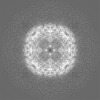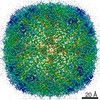[English] 日本語
 Yorodumi
Yorodumi- EMDB-51779: Structure of apoferritin determined at 13K in 100 nm diameter holes. -
+ Open data
Open data
- Basic information
Basic information
| Entry | 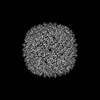 | |||||||||
|---|---|---|---|---|---|---|---|---|---|---|
| Title | Structure of apoferritin determined at 13K in 100 nm diameter holes. | |||||||||
 Map data Map data | ||||||||||
 Sample Sample |
| |||||||||
 Keywords Keywords | Protein Complex / METAL BINDING PROTEIN | |||||||||
| Biological species |  | |||||||||
| Method | single particle reconstruction / cryo EM / Resolution: 2.83 Å | |||||||||
 Authors Authors | Dickerson JL / Naydenova K / Peet MJ / Wilson H / Nandy B / McMullan G / Morrison R / Crusso CJ | |||||||||
| Funding support |  United Kingdom, 1 items United Kingdom, 1 items
| |||||||||
 Citation Citation |  Journal: Proc Natl Acad Sci U S A / Year: 2025 Journal: Proc Natl Acad Sci U S A / Year: 2025Title: Reducing the effects of radiation damage in cryo-EM using liquid helium temperatures. Authors: Joshua L Dickerson / Katerina Naydenova / Mathew J Peet / Hugh Wilson / Biplob Nandy / Greg McMullan / Robert Morrison / Christopher J Russo /  Abstract: The physical limit in determining the atomic structure of biological molecules is radiation damage. In electron cryomicroscopy, there have been numerous attempts to reduce the effects of radiation ...The physical limit in determining the atomic structure of biological molecules is radiation damage. In electron cryomicroscopy, there have been numerous attempts to reduce the effects of radiation damage by cooling the specimen beyond liquid-nitrogen temperatures, yet all failed to realize the potential improvement for single-particle structure determination. We have identified the physical causes of information loss at liquid-helium temperatures, and overcome them using a combination of nanoscale electron beam illumination and a gold specimen support with 100 nm diameter holes. This combination allowed structure determination where every frame in the exposure contained more information than was available with cryomicroscopy at liquid-nitrogen temperatures, matching expectations from crystal diffraction. Since a 100 nm hole is smaller than the field of view of a typical micrograph, the edges of the foil are directly visible in each micrograph. Protein molecules that are degraded tend to aggregate at the edges of foil holes and can constitute a significant fraction of the micrograph. This and the need for minimal water-foil irradiation will both be important to consider as new cryomicroscopes and specimen supports are developed for imaging molecules at extremely low temperatures where the effects of radiation damage are reduced. | |||||||||
| History |
|
- Structure visualization
Structure visualization
| Supplemental images |
|---|
- Downloads & links
Downloads & links
-EMDB archive
| Map data |  emd_51779.map.gz emd_51779.map.gz | 8.5 MB |  EMDB map data format EMDB map data format | |
|---|---|---|---|---|
| Header (meta data) |  emd-51779-v30.xml emd-51779-v30.xml emd-51779.xml emd-51779.xml | 12.6 KB 12.6 KB | Display Display |  EMDB header EMDB header |
| FSC (resolution estimation) |  emd_51779_fsc.xml emd_51779_fsc.xml | 9.1 KB | Display |  FSC data file FSC data file |
| Images |  emd_51779.png emd_51779.png | 129.6 KB | ||
| Masks |  emd_51779_msk_1.map emd_51779_msk_1.map | 64 MB |  Mask map Mask map | |
| Filedesc metadata |  emd-51779.cif.gz emd-51779.cif.gz | 4 KB | ||
| Others |  emd_51779_half_map_1.map.gz emd_51779_half_map_1.map.gz emd_51779_half_map_2.map.gz emd_51779_half_map_2.map.gz | 45.8 MB 45.8 MB | ||
| Archive directory |  http://ftp.pdbj.org/pub/emdb/structures/EMD-51779 http://ftp.pdbj.org/pub/emdb/structures/EMD-51779 ftp://ftp.pdbj.org/pub/emdb/structures/EMD-51779 ftp://ftp.pdbj.org/pub/emdb/structures/EMD-51779 | HTTPS FTP |
-Validation report
| Summary document |  emd_51779_validation.pdf.gz emd_51779_validation.pdf.gz | 960.9 KB | Display |  EMDB validaton report EMDB validaton report |
|---|---|---|---|---|
| Full document |  emd_51779_full_validation.pdf.gz emd_51779_full_validation.pdf.gz | 960.4 KB | Display | |
| Data in XML |  emd_51779_validation.xml.gz emd_51779_validation.xml.gz | 15.4 KB | Display | |
| Data in CIF |  emd_51779_validation.cif.gz emd_51779_validation.cif.gz | 21 KB | Display | |
| Arichive directory |  https://ftp.pdbj.org/pub/emdb/validation_reports/EMD-51779 https://ftp.pdbj.org/pub/emdb/validation_reports/EMD-51779 ftp://ftp.pdbj.org/pub/emdb/validation_reports/EMD-51779 ftp://ftp.pdbj.org/pub/emdb/validation_reports/EMD-51779 | HTTPS FTP |
-Related structure data
- Links
Links
| EMDB pages |  EMDB (EBI/PDBe) / EMDB (EBI/PDBe) /  EMDataResource EMDataResource |
|---|
- Map
Map
| File |  Download / File: emd_51779.map.gz / Format: CCP4 / Size: 64 MB / Type: IMAGE STORED AS FLOATING POINT NUMBER (4 BYTES) Download / File: emd_51779.map.gz / Format: CCP4 / Size: 64 MB / Type: IMAGE STORED AS FLOATING POINT NUMBER (4 BYTES) | ||||||||||||||||||||||||||||||||||||
|---|---|---|---|---|---|---|---|---|---|---|---|---|---|---|---|---|---|---|---|---|---|---|---|---|---|---|---|---|---|---|---|---|---|---|---|---|---|
| Projections & slices | Image control
Images are generated by Spider. | ||||||||||||||||||||||||||||||||||||
| Voxel size | X=Y=Z: 0.83 Å | ||||||||||||||||||||||||||||||||||||
| Density |
| ||||||||||||||||||||||||||||||||||||
| Symmetry | Space group: 1 | ||||||||||||||||||||||||||||||||||||
| Details | EMDB XML:
|
-Supplemental data
-Mask #1
| File |  emd_51779_msk_1.map emd_51779_msk_1.map | ||||||||||||
|---|---|---|---|---|---|---|---|---|---|---|---|---|---|
| Projections & Slices |
| ||||||||||||
| Density Histograms |
-Half map: #2
| File | emd_51779_half_map_1.map | ||||||||||||
|---|---|---|---|---|---|---|---|---|---|---|---|---|---|
| Projections & Slices |
| ||||||||||||
| Density Histograms |
-Half map: #1
| File | emd_51779_half_map_2.map | ||||||||||||
|---|---|---|---|---|---|---|---|---|---|---|---|---|---|
| Projections & Slices |
| ||||||||||||
| Density Histograms |
- Sample components
Sample components
-Entire : Mouse heavy-chain apoferritin
| Entire | Name: Mouse heavy-chain apoferritin |
|---|---|
| Components |
|
-Supramolecule #1: Mouse heavy-chain apoferritin
| Supramolecule | Name: Mouse heavy-chain apoferritin / type: complex / ID: 1 / Parent: 0 |
|---|---|
| Source (natural) | Organism:  |
-Experimental details
-Structure determination
| Method | cryo EM |
|---|---|
 Processing Processing | single particle reconstruction |
| Aggregation state | particle |
- Sample preparation
Sample preparation
| Buffer | pH: 7.5 |
|---|---|
| Vitrification | Cryogen name: ETHANE |
- Electron microscopy
Electron microscopy
| Microscope | FEI POLARA 300 |
|---|---|
| Temperature | Min: 13.0 K / Max: 13.0 K |
| Image recording | Film or detector model: GATAN K2 BASE (4k x 4k) / Average electron dose: 58.0 e/Å2 |
| Electron beam | Acceleration voltage: 300 kV / Electron source:  FIELD EMISSION GUN FIELD EMISSION GUN |
| Electron optics | Illumination mode: FLOOD BEAM / Imaging mode: BRIGHT FIELD / Nominal defocus max: 2.7 µm / Nominal defocus min: 0.7000000000000001 µm |
| Sample stage | Cooling holder cryogen: HELIUM |
| Experimental equipment | 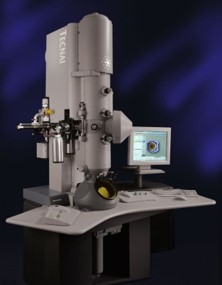 Model: Tecnai Polara / Image courtesy: FEI Company |
 Movie
Movie Controller
Controller



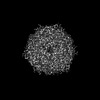
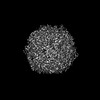





 Z (Sec.)
Z (Sec.) Y (Row.)
Y (Row.) X (Col.)
X (Col.)





































